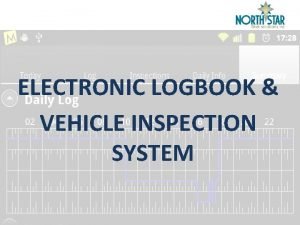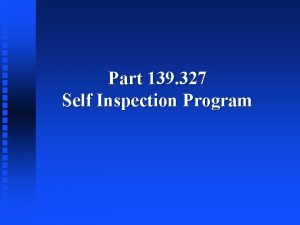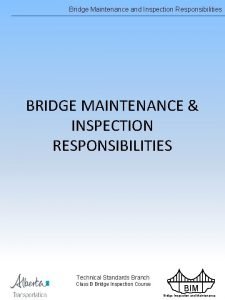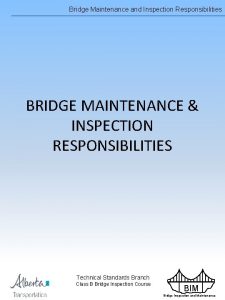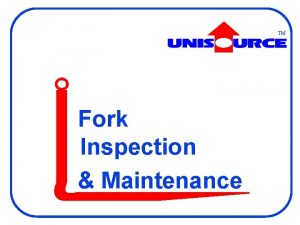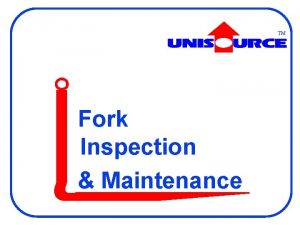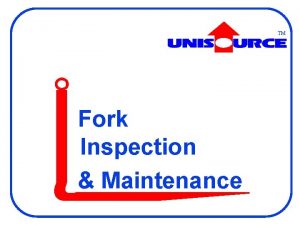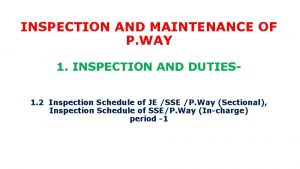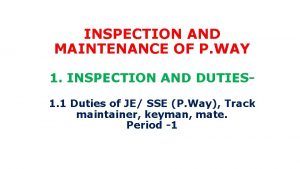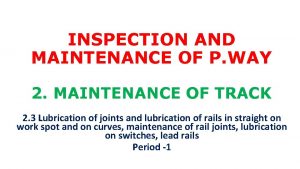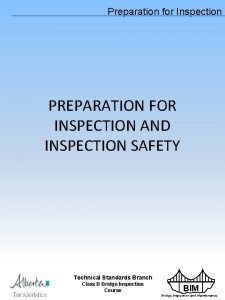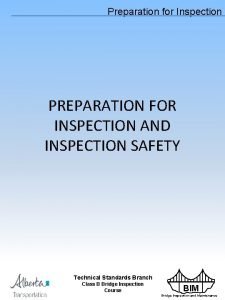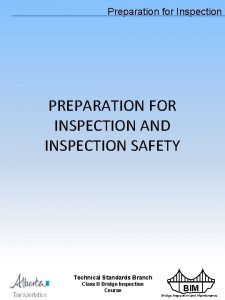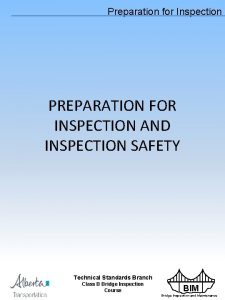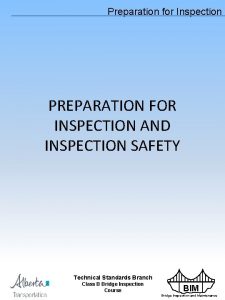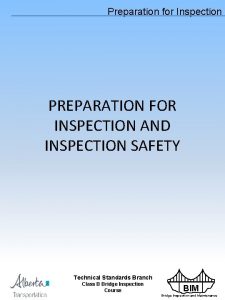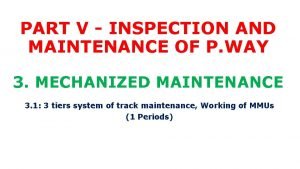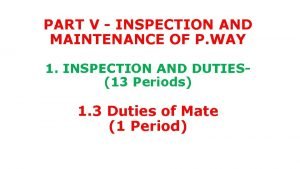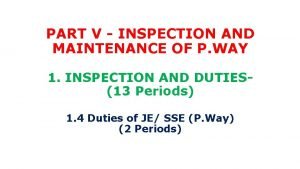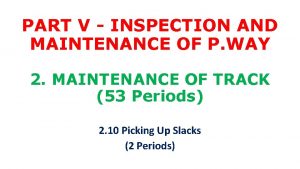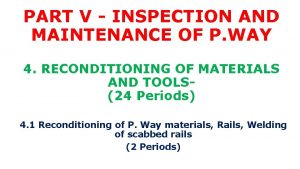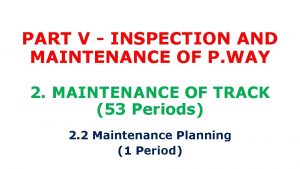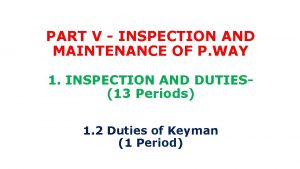PART V INSPECTION AND MAINTENANCE OF P WAY
























- Slides: 24

PART V - INSPECTION AND MAINTENANCE OF P. WAY 2. MAINTENANCE OF TRACK (53 Periods) 2. 3 Through Packing by Conventional Manual Method (1 Period)

Through Packing Method: - by Conventional Manual • Normally manual through packing is not to be done in concrete sleeper track. • However, in locations of slacks where multipurpose tampers are not available, following steps in sequence shall be followed.

Through Packing by Conventional Manual Method: • The length of track opened out on any one day shall not be more than that can be efficiently tackled before the end of the day– (a) Opening of the road. (b) Examination of rails, sleepers and fastenings. (c) Squaring of sleepers. (d) Slewing of track to correct alignment.

Through Packing by Conventional Manual Method: (e) Gauging. (f) Packing of sleepers. (g) Repacking of joint sleepers. (h) Boxing of ballast section and tidying.

• The details of various steps listed above is given in Annexure - 6/9 of IRPWM. The provisions of Part D of Chapter 3 of IRPWM should be followed, wherever through packing is being done in LWR/CWR track. • Appropriate small track machines should be deployed instead of conventional tools for carrying out various operations, wherever feasible.

Details of the 8 operations of Systematic Through Packing are as detailed below– 1. Opening of Road– • Ballast should be opened out on either side of the rail seats to the extent from end of sleepers to 450 mm inside of the rail seat to a depth of 50 mm below the packing surface without disturbing the cores under the sleepers.

Details of the 8 operations of Systematic Through Packing are as detailed below– 1. Opening of Road– • The ballast should be drawn by phowrahs/ shovels or rake iron ballast outwards and inwards i. e. that portion of the ballast on the outside of the rail should be drawn outwards, the portions between the rails being drawn towards the centre, care however, should be taken to see that the ridge between the rails does not project more than 50 mm above rail level.

2. Examination of Rails, Sleepers and Fastenings– (i) Rails should be examined, the underside for corrosion, the ends for cracks, the head for top and side wear, rail joints for wear on the fishing planes, fish bolts for tightness. 1) If rails on curves wear at an unusually rapid rate, lubrication of the gauge face should be done. 2) Rust and dust must be removed from the corroded rails by using wire brushes. 3) Kinks in rails should be removed by Jim crowing.

2. Examination of Rails, Sleepers and Fastenings– (ii) Sleepers should be inspected for their condition and soundness particularly at the rail seats. (iii) Fastenings and fittings should be examined to ensure that they are in good order, appropriately tightened so that they firmly hold the rails. Broken ones should be replaced immediately.

3. Squaring of sleepers– Gauge variations and kinks inevitably result from sleepers getting out of square, therefore the spacing of sleepers on the sighting rail should first be checked and correctly chalk – marked. Corresponding marks should then be made on the other rail using the square at every point. The core of sleepers that are out-of-square should then be ‘picked’ with the pick ends of beaters, the fastenings loosened and the sleepers levered and squared to correct position.

3. Squaring of sleepers– Squaring should be done by using mechanical/hydraulic spacer or by planting the crow bars firmly against the sleeper and pushing it. Under no circumstances should sleepers be hammered. Sleepers that are squared should be re-gauged immediately, the fastenings tightened and repacked.

4. Slewing of track to correct alignment– (i) Heavy slewing will only be required during realignment of curves when it will be necessary to loosen the rail, joints and the packing cores being broken with the pick-ends of beaters. Slewing for normal maintenance will be of a small order and should be done after opening out the road, loosening the cores at ends and drawing out sufficient ballast at the ends of the sleepers. (ii) Slewing of track shall be directed by the Mate, who should sight the rail from a distance of 30 to 60 meters on straight track. On curves, the Gang Mate should sight the outer rail.

4. Slewing of track to correct alignment– (iii) Slewing is best done in the morning unless it is cloudy, as later on, sighting conditions become unfavourable. (iv) Slewing should preferably be done using hydraulic/mechanical jacks or TRALIS. If crow bars are used, these should be planted well into the ballast at an angle not more than 30 degrees from the vertical; otherwise lifting of the track may occur.

5. Gauging– (i) Preservation of gauge is an important part of track maintenance especially through points and crossings. For good riding, the basic requirement is uniform gauge over a continuous stretch of track and such gauge should be allowed to continue so long as it is within the permissible limits of tightness or slackness. (ii) Gauging should only be done after ensuring that sleepers are truly square.

5. Gauging– (iii) The track gauge cum level should be held firm with one lug against the base rail, and the other end being swivelled over the opposite rails. The tightest position obtained determines the correct point to test the gauge. The gauge cum level should not be forced as that causes considerable wear on the gauge lug. (iv) While it is desirable to maintain correct gauge, it may not be possible to maintain correct gauge due to wear in rail and sleeper inserts. It is good practice to work within the tolerances of gauge, as specified in Para 525 (1) of IRPWM, provided generally uniform gauge can be maintained over long lengths.

6. Packing of sleepers– (i) The aim of packing is to have each sleeper firmly and uniformly packed to ensure that the rails are at their correct relative levels i. e. , level on the straight track and to the required cant on curves and that no sleeper has any void between it and its bed. (ii) Before packing is commenced, it is necessary to ensure that all the fittings are intact. Wherever feasible packing is to be done by worksite tampers. However, if worksite tampers are not available, manual packing as detailed below may be done.

6. Packing of sleepers– (iii) The Gang Mate shall sight the base rail with eye along the lower edge of the head of rail and any dip or low joint lifted correctly. The adjacent sleepers should then be packed and the top checked. After two rail lengths have been attended to, the rail on the other side should be brought to the correct level by checking cross level with the gauge-cum-level at every rail joint and at every fourth sleeper. The next two rail lengths should then be taken up and the process continued. (iv) No joint or dip should be lifted higher than the proper level in the expectation that it will settle to the correct level. Instead it will settle more under traffic as a result of being high and cause rough running.

6. Packing of sleepers– (v) Having aligned the track and the rail table adjusted, Track Maintainers should be distributed in batches of two for packing all sleepers in a systematic manner, commencing from one end. Four men should deal with every sleeper successively, two at each rail seat. The ballast under the sleeper should be packed by the men standing back-to-back and working their off track hand held tampers diagonally under the rail seat at the same time to ensure firm packing. Where off track hand held tampers are not available the packing can be done by crowbars / straightening bars. (vi) While using crowbars, it is important that the cores are thoroughly broken before packing and re-packed.

6. Packing of sleepers– (vii) After packing the rail seat, the packing should be continued outwards and inwards to the requisite extent on each side of the rail seat i. e. , end of the sleeper to 450 mm inside, the strokes being kept as nearly horizontal as possible. Care must be taken to avoid forcing any large stone under the sleeper so as not to cause uneven bearing and to avoid striking the edges of the sleepers. All men should aim to work the crowbars from the same height so that the sleepers are uniformly packed. Higher or lower lifting of the crowbars results in uneven compactness.

6. Packing of sleepers– (viii) Before final dressing is done, it should be ensured that no sleeper is centre-bound by working the pick-ends over the central range. Centre bound sleepers cause vehicles to roll from side to side. (ix) Care must also be taken while packing to ensure that the work does not result in the sleepers adjoining those being packed, lifted off their bed, thus creating artificial voids under them.

6. Packing of sleepers– (x) The packing on the inside and outside at every rail seat should, before boxing the track, be checked by the Gang Mate by tapping with a rubberised Canne-a boule. An inadequate rebound would indicate defective packing, which should be attended to again. (xi) As soon as the packing is completed, slight distortions in alignment and top should be checked and corrected by the Mate, the sleeper disturbed for this purpose being finally repacked.

7. Repacking of joint sleepers– The joint and ‘shoulder’ sleepers should be repacked, before boxing is done and the cross- levels at joints checked. The rail joint being the weakest portion, firmness of its support is essential.

8. Boxing of Ballast section and Tidying– (i) After completing the preceding operations in sequence, clean ballast should be worked in with ballast forks or rakes. The ballast section should be dressed to the specified dimensions, a template being used for the purpose. Hemp cords 6 mm dia. of sufficient length should be used for lining the top and bottom edges of the ballast section. Where the quantity of ballast is inadequate, full section of ballast should be provided near the rail seat, the deficiency being reflected along the centre of the track and not under the rails or in the shoulders.

8. Boxing of Ballast section and Tidying– (ii) The cess should then be tidied up. (iii) Where earth ridging exists at the edge of the bank, it should be removed. (iv) Cess should be maintained to the correct depth below rail level according to the ballast-section and formation profile. Too high a cess affects drainage; too low a cess results in ballast-spread and wastage.
 Dd 5988
Dd 5988 E.l.v.i.s. inspection form
E.l.v.i.s. inspection form Rac periodic maintenance inspection
Rac periodic maintenance inspection Regular vessel and engine maintenance program
Regular vessel and engine maintenance program Part 139 inspection
Part 139 inspection Key club meaning
Key club meaning Advantages of threaded binary tree
Advantages of threaded binary tree Perbedaan two way anova dan one way anova
Perbedaan two way anova dan one way anova Conventional software
Conventional software Understand quran and salah easy way short course#2 pdf
Understand quran and salah easy way short course#2 pdf Two way anova
Two way anova One way anova null hypothesis
One way anova null hypothesis One way anova vs two way anova
One way anova vs two way anova Pengertian two way anova
Pengertian two way anova This way that way forwards backwards over the irish sea
This way that way forwards backwards over the irish sea Walk this way talk this way
Walk this way talk this way Part part whole addition
Part part whole addition Part to part ratio definition
Part to part ratio definition Part part whole
Part part whole Technical description
Technical description Parts of cocktail bar
Parts of cocktail bar The part of a shadow surrounding the darkest part
The part of a shadow surrounding the darkest part Two way anova minitab 17
Two way anova minitab 17 Records and reports in nursing
Records and reports in nursing Types of security survey
Types of security survey

